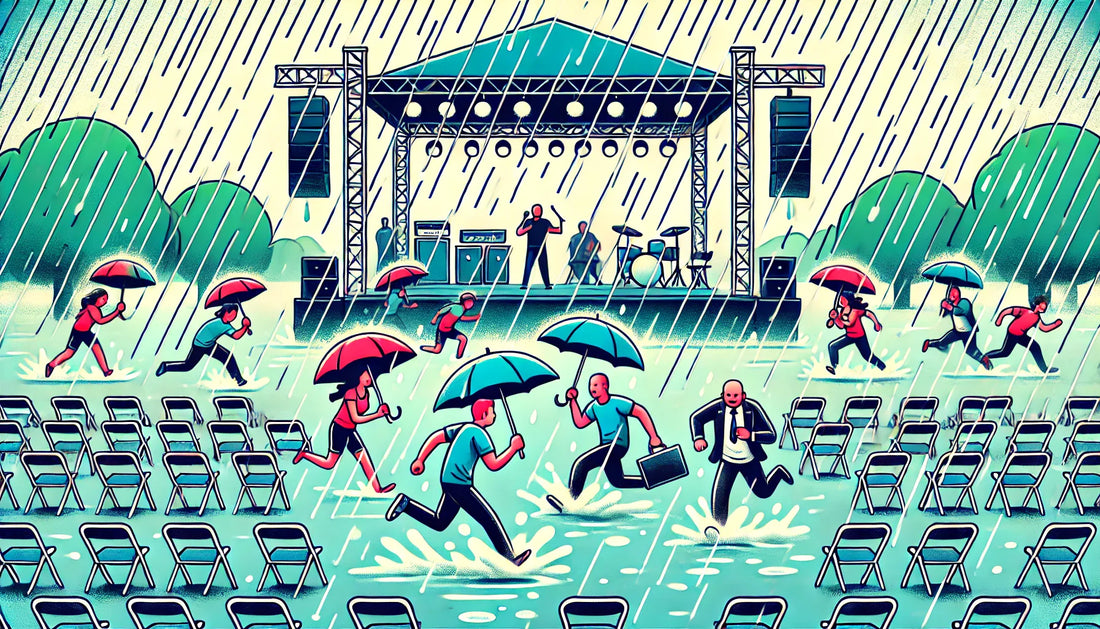
From Panic to Perfect: How to Handle Common Event Day Disasters
Share
Imagine this: It's event day. The room is set, the guests are arriving, and everything seems to be running smoothly. Suddenly — disaster strikes. The keynote speaker’s microphone cuts out. The caterer is stuck in traffic. The forecasted clear skies are now storm clouds rolling in fast.
Even the most carefully planned events can face unexpected hurdles — but disaster doesn’t have to mean disaster. With smart preparation and quick thinking, you can turn panic into success. Here's how to handle some of the most common event-day crises with confidence.
1. Tech Troubles – When Equipment Fails
The scenario: The room is full, the audience is ready, but when the speaker steps up to the mic… silence. The screen flickers, and the presentation refuses to load.
Prevention:
-
Test all audio-visual equipment both the day before and again on the morning of the event.
-
Ensure spare cables, batteries, and a backup laptop are on hand.
-
Have digital files stored on multiple devices (USB, cloud storage, etc.) for easy retrieval.
Emergency Fix:
-
If the microphone fails, have a backup mic or portable speaker ready.
-
If a presentation won’t load, keep a printed version of key slides or a verbal summary prepared to deliver manually.
-
Calmly acknowledge the issue to the audience to maintain trust — silence can increase anxiety for both you and your guests.
✅ Pro Tip: Assign a dedicated ‘tech troubleshooter’ who is familiar with the venue’s setup and can step in immediately when problems arise.
2. Vendor No-Shows or Delays
The scenario: The caterer hasn’t arrived, or a key supplier’s delivery is nowhere to be seen.
Prevention:
-
Confirm all bookings 1-2 weeks before the event and again the day before.
-
Compile a list of backup vendors in case of cancellations.
-
For catering, order extra non-perishable snacks that can be set out in an emergency.
Emergency Fix:
-
If the caterer is delayed, arrange for drinks to be served immediately to keep guests comfortable while you manage the situation.
-
In the case of missing décor or equipment, consider creative solutions — rearranging furniture, borrowing supplies from the venue, or moving activities to a different area can sometimes salvage the scene.
✅ Pro Tip: Build buffer time into your schedule to allow for delays. For example, if lunch is set for 12:30 p.m., tell your caterer to arrive by noon.
3. Weather Woes at Outdoor Events
The scenario: Blue skies in the morning turn into sudden downpours by mid-afternoon, leaving your outdoor seating soaked and your guests scrambling for cover.
Prevention:
-
Always have a backup indoor space or tent ready — even if you don’t think you’ll need it.
-
Invest in umbrellas, waterproof coverings, or portable heaters as contingency items.
Emergency Fix:
-
If indoor space isn’t available, guide guests to covered walkways, overhangs, or nearby sheltered areas.
-
Use social media or event apps to instantly inform attendees of location changes or delays.
✅ Pro Tip: In unpredictable climates, consider providing guests with event-branded ponchos or umbrellas — a practical solution that doubles as a memorable keepsake.
4. Guest or Speaker No-Shows
The scenario: Your headline speaker calls in sick an hour before their presentation, or VIP guests cancel last minute.
Prevention:
-
Secure multiple speakers or panelists in advance so that one absence doesn’t derail your schedule.
-
Design your agenda with flexible activities that can fill unexpected gaps — such as networking sessions, discussion panels, or interactive elements.
Emergency Fix:
-
Ask an industry expert or team member to step in for an impromptu Q&A.
-
Encourage guests to participate by facilitating a group discussion or breakout session in place of the absent speaker.
✅ Pro Tip: Prepare a few “bonus” activities in advance that can slot into your schedule — such as trivia games, speed networking, or mini icebreakers. These can fill gaps seamlessly and keep energy levels high.
5. Medical or Safety Emergencies
The scenario: A guest faints, cuts themselves, or suffers an allergic reaction.
Prevention:
-
Assign a designated first-aider from your staff or hire a professional medic for larger events.
-
Identify the nearest hospital or urgent care center and ensure staff know the quickest route.
-
Provide your team with clear instructions on how to manage crowd control and emergencies.
Emergency Fix:
-
Act quickly but calmly. Assign one person to assist the individual directly, while another notifies medical services.
-
Keep crowds calm by communicating clearly and reassuring attendees that the situation is under control.
✅ Pro Tip: Include emergency information in your event program or digital app so attendees know how to report issues quickly.
Checklist for Quick Reference
Here’s a quick recap of your event-day disaster toolkit:
✔️ Tech issues? Test equipment in advance and prepare backups.
✔️ Vendors unreliable? Confirm ahead of time and keep a list of alternatives.
✔️ Unpredictable weather? Have a flexible indoor backup plan ready.
✔️ Speaker cancels? Prepare flexible activities or backup content.
✔️ Medical emergency? Assign a first-aider and have emergency contacts handy.
Conclusion
No matter how much preparation goes into your event, unexpected issues can still arise. But by preparing for these common disasters — and knowing how to respond calmly and effectively — you can turn potential chaos into a smooth and successful experience.
For more tips on planning standout events, check out our other blog posts or follow us on social media to stay ahead of the curve.
